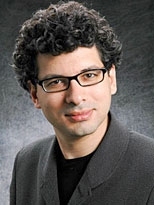"Almost every composer in my generation uses a computer," says Keeril Makan, who, like many of his peer group, seeks ways to incorporate digital media and cutting-edge technology into his music.
Makan, 35, is a sought-after contemporary composer who has received commissions from various ensembles and organizations all over the country and has participated in music festivals around the world. He joined the MIT community this fall as an assistant professor of music and teaches courses in music theory and composition.
One of his earlier pieces for violin and percussion, "2," will be performed next month in Boston as part of the Boston Modern Orchestra Project Club Concert series.
Makan, who takes his influences from American folk music, the European avant-garde, Indian classical music and minimalism, considers "2," written in 1998, to be the beginning of a long creative process. Most importantly, "2" marks the time when Makan began using a computer as a tool during composition.
"The computer served as a modeling environment," explained Makan. "I could hear what I was doing, and I could take ideas to a further extreme than I would have if I was just working on paper. I could force myself into positions that were purposely uncomfortable to explore something new about the way I was hearing continuity in music."
While Makan acknowledges that the computer was essential to the composition of the piece, it wasn't because of the way the computer sounded; it was more in the experience of time that the computer afforded him during the composition process.
A performer by nature (he played both the violin and oboe growing up), Makan isn't interested in purely electro-acoustic work. He's happier when he creates a "hybrid world where you can't tell where the acoustic ends or the electro-acoustic begins," he said.
And while Makan believes that the future of music will include technology, he noted that how technology is used will depend on the composer: Some composers only use their computers for notation, while others, like Makan, incorporate the use of the computer into the composition process, using it as an earphone.
Makan received his degrees in composition and religion at Oberlin College and Conservatory in Ohio and completed his Ph.D. in composition at the University of California at Berkeley; he began composing at a summer camp in a classroom environment.
"The teacher walked in and said, 'Composing is like painting; time is your frame and sound is your palette of color. Now go compose,'" recalled Makan with a laugh. "There was no instruction whatsoever." That teacher's philosophy, however, has been invaluable to Makan's confidence.
"If you have a connection to sound and you want to work with it, then you can find a way to do it. You can begin to compose," he says.
"2" will be performed on Tuesday, Dec. 5, with Gabriela Diaz on violin and Aaron Trant on percussion, at 7 p.m. at the Moonshine Room, Club Café. (209 Columbus Ave., Boston). Tickets cost $15. For more information, call (617) 363-0396.
A version of this article appeared in MIT Tech Talk on November 22, 2006 (download PDF).






